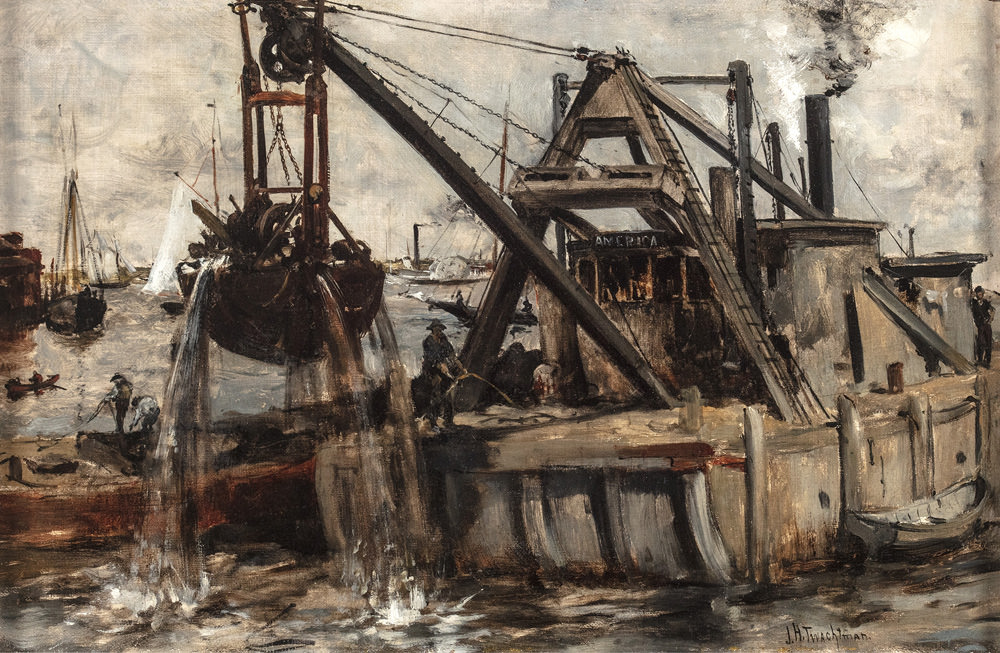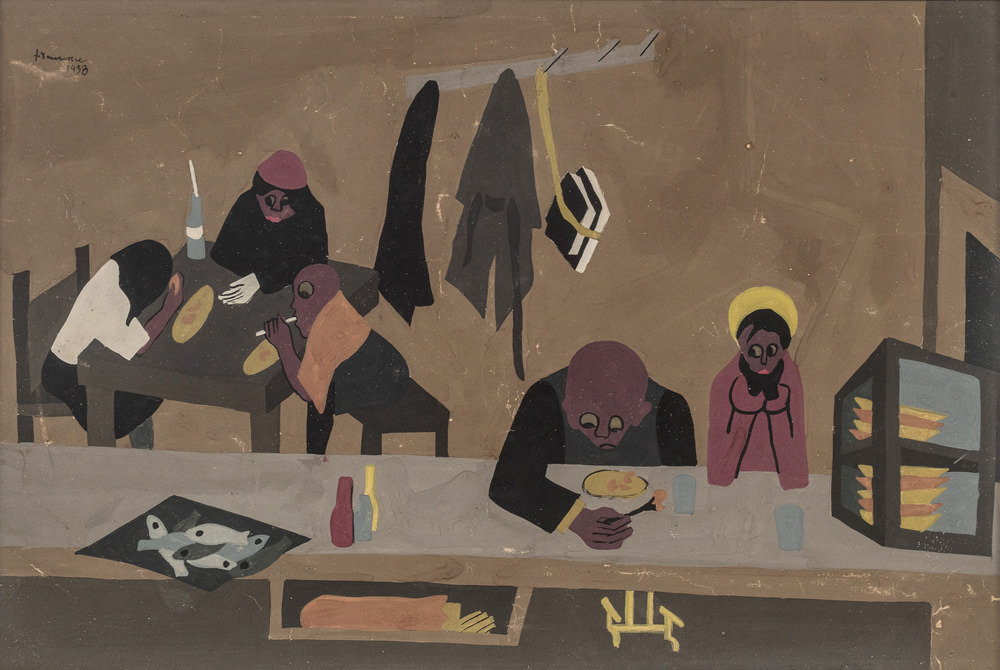
The last few weeks I’ve taken to walking through the southern end of Central Park, sometimes skewing west around the ball field, more often circling the lake at the eastern corner. As yet the furthest north I’ve gone is the Sheep Meadow. Along the way I pass street musicians of various aptitudes, vendors, the carousel, and people lying in the grass, enjoying the last sunny, temperate days of fall. It’s been more than forty years since I moved to New York to study at the League, and rediscovering the park stirs up the soil of memory, as it were, to days of touch football, Frisbee and early forays into plein-air painting. With the pump of personal reverie primed, I was prepared to absorb a broader nostalgia, a show covering two hundred years of the city’s visual charms. Of a recent morning I walked up Central Park West to the New-York Historical Society to view Scenes of New York City: The Elie and Sarah Hirschfeld Collection.
About forty years ago, Elie Hirschfeld started to amass his collection. Mr. Hirschfeld is a philanthropist whose resources are nigh limitless; the scion of a real estate colossus, he has partnered in business with a certain former President. In 2017 he purchased a black marker drawing of the Empire State Building at auction for $16,000, with the explanation that “This piece came up and I found it to be a stunning addition to my collection. Donald Trump is an artist.” One may not take that explanation seriously, but news of the sale prompted an article in GQ Magazine, entitled “Donald Trump’s Sketch of the Empire State Building Is Genuinely the Worst Art I’ve Ever Seen.”
The good news is that curatorial discretion triumphed at the N-YHS—if you have something like the desire to slow down and gawk at a wreck, the Trump drawing is viewable here. The Hirschfeld collection numbers 130 pieces promised as a gift to the Historical Society. There are pleasures and curiosities, with the strengths generally focused on early to mid-twentieth century city scenes. Many of the artists were affiliated with the League.

Some of the pleasures, in no particular order. John Twachtman’s Dredging the River presages the Ashcan school by nearly thirty years. It is a terrific early work, its forceful contrasts and hard edges well-suited to the subject, and a type of painting to which he would not return. High Bridge Aqueduct is a typical Ernest Lawson canvas, the paint accreted with a knife, filtered through the prism of a French palette (if that’s not French enough, there’s a Renoiresque view of Washington Square by William Glackens). Jacob Lawrence’s Harlem Diner hits a pathos that has aged better than the satires of George Grosz or Otto Dix; though the latter were recent emigres from Nazi Germany, Lawrence’s experience was that of an African American who couldn’t escape alienation in his native land. Although Martin Lewis is rightly known for his skills as a printmaker and instructor—Hopper learned etching from him—he was equally gifted as a painter. Lewis’s Tottenville, Staten Island and Spiral Staircase, Queensboro Bridge show a fine eye for sunlight and the geometry of cityscape. The same can be said of Reginald Marsh, whether taking the panoramic view of Manhattan Skyline with the Brooklyn Bridge or the surprisingly abstracted design of Construction, Steel Workers. Thematically, this is the centerpiece of the collection; in a wall note for the painting, Hirschfeld writes, “I am a lifelong developer of New York City real estate. This work shows all the dynamism of building the city that I love. To me, the vitality, action and beauty of this painting epitomize New York City and is at the core of our collection. I am inspired every time I see it.” In the monumental vein, Brooklyn Bridge is celebrated in large pieces by Georgia O’ Keeffe and Andy Warhol. I like the stacking of small paintings by Rackstraw Downes and Gari Melchers, essays on light-struck architecture separated by eighty-five years.

Curiosities include youthful cityscapes painted by Franz Kline and Mark Rothko, both dealing with traditional approaches to perspective; an immense rollicking street scene by Red Grooms; a Kline abstraction painted on a page torn from the New York phone book and a Willem de Kooning painted on a page from the New York Times. We are told that John Marin painted the view from his hospital bed using a syringe to create the architectural lines. Many works are devoted to the city’s parks, among them an early Norman Rockwell oil, competent and uninspired, depicting a boy and an elderly man in Gramercy Park. Paintings by Adolf Dehn, Paul Cornoyer, and Gifford Beal, all inveterate observers of the cityscape, get some of the magic of Manhattan’s green spaces. Of historical interest is a bucolic canvas by George Lafayette Clough, which purports to show Prospect Park, Brooklyn, in 1870, a time when the park was still being created. It easily predates William Merritt Chase’s scenes of the 1880s, sometimes regarded as the earliest urban park paintings by an American artist. One of the most recent works is a large venture in photorealism that depicts the facade of the city’s first Hard Rock Cafe, which existed next door to the Art Students League, where the Nordstrom tower now stands. If New York’s architecture is central to the collection, then its inconstancy provides subtext. Several works depict the Singer Building—once one of New York’s great Beaux-Arts skyscrapers, it was demolished to make room for a larger building in the 1960s. This is art recording the passage of time, via relentless development.
The Hirschfeld collection doesn’t claim to be comprehensive. Missing are the great park scenes by Chase and Prendergast, the romantic physicality of George Bellows or Jonas Lie, or, except for a minor Isabel Bishop drawing, anything much in the vein of social realism. There’s neither the grit of Marsh’s drawings of the working class (his city scenes are nonetheless a highlight of the collection) nor the mid-century cocktail party life of John Koch. Notwithstanding its shortcomings, the Rockwell is nearly exceptional for its portrayal of human interaction. Mr. Hirschfeld’s self-proclaimed interests reside elsewhere. He summarized a meeting with Warhol at his studio in 1983: “When we stopped at a window overlooking the (Union) Square, I mentioned that I was developing the project in construction at the other corner. From then on, he only wanted to talk real estate. We had a lot of fun.”
Scenes of New York City: The Elie and Sarah Hirschfeld Collection was curated by Wendy Nālani E. Ikemoto, curator of American art, with research contributions from Roberta J.M. Olson, curator of drawings emerita. It is on view at the New-York Historical Society through February 27, 2021.



